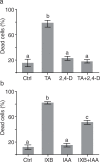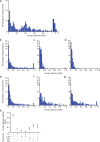Auxin protects Arabidopsis thaliana cell suspension cultures from programmed cell death induced by the cellulose biosynthesis inhibitors thaxtomin A and isoxaben
- PMID: 31752698
- PMCID: PMC6873746
- DOI: 10.1186/s12870-019-2130-2
Auxin protects Arabidopsis thaliana cell suspension cultures from programmed cell death induced by the cellulose biosynthesis inhibitors thaxtomin A and isoxaben
Abstract
Background: Thaxtomin A (TA) is a natural cellulose biosynthesis inhibitor (CBI) synthesized by the potato common scab-causing pathogen Streptomyces scabies. Inhibition of cellulose synthesis by TA compromises cell wall organization and integrity, leading to the induction of an atypical program of cell death (PCD). These processes may facilitate S. scabies entry into plant tissues. To study the mechanisms that regulate the induction of cell death in response to inhibition of cellulose synthesis, we used Arabidopsis thaliana cell suspension cultures treated with two structurally different CBIs, TA and the herbicide isoxaben (IXB).
Results: The induction of cell death by TA and IXB was abrogated following pretreatment with the synthetic auxin 2,4-dichlorophenoxyacetic acid (2,4-D) and the natural auxin indole-3-acetic acid (IAA). The addition of auxin efflux inhibitors also inhibited the CBI-mediated induction of PCD. This effect may be due to intracellular accumulation of auxin. Auxin has a wide range of effects in plant cells, including a role in the control of cell wall composition and rigidity to facilitate cell elongation. Using Atomic Force Microscopy (AFM)-based force spectroscopy, we found that inhibition of cellulose synthesis by TA and IXB in suspension-cultured cells decreased cell wall stiffness to a level slightly different than that caused by auxin. However, the cell wall stiffness in cells pretreated with auxin prior to CBI treatment was equivalent to that of cells treated with auxin only.
Conclusions: Addition of auxin to Arabidopsis cell suspension cultures prevented the TA- and IXB-mediated induction of cell death. Cell survival was also stimulated by inhibition of polar auxin transport during CBI-treatment. Inhibition of cellulose synthesis perturbed cell wall mechanical properties of Arabidopsis cells. Auxin treatment alone or with CBI also decreased cell wall stiffness, showing that the mechanical properties of the cell wall perturbed by CBIs were not restored by auxin. However, since auxin's effects on the cell wall stiffness apparently overrode those induced by CBIs, we suggest that auxin may limit the impact of CBIs by restoring its own transport and/or by stabilizing the plasma membrane - cell wall - cytoskeleton continuum.
Keywords: Auxin; Calcium; Cell wall; Isoxaben; Programmed cell death; Thaxtomin A.
Conflict of interest statement
The authors declare that they have no competing interests.
Figures




Similar articles
-
Enhanced resistance to the cellulose biosynthetic inhibitors, thaxtomin A and isoxaben in Arabidopsis thaliana mutants, also provides specific co-resistance to the auxin transport inhibitor, 1-NPA.BMC Plant Biol. 2013 May 3;13:76. doi: 10.1186/1471-2229-13-76. BMC Plant Biol. 2013. PMID: 23638731 Free PMC article.
-
Transcriptional profiling in response to inhibition of cellulose synthesis by thaxtomin A and isoxaben in Arabidopsis thaliana suspension cells.Plant Cell Rep. 2009 May;28(5):811-30. doi: 10.1007/s00299-009-0670-x. Epub 2009 Feb 7. Plant Cell Rep. 2009. PMID: 19198845
-
Thaxtomin A induces programmed cell death in Arabidopsis thaliana suspension-cultured cells.Planta. 2005 Nov;222(5):820-31. doi: 10.1007/s00425-005-0016-z. Epub 2005 Jul 15. Planta. 2005. PMID: 16025344
-
Cellulose biosynthesis inhibitors - a multifunctional toolbox.J Exp Bot. 2016 Jan;67(2):533-42. doi: 10.1093/jxb/erv489. Epub 2015 Nov 19. J Exp Bot. 2016. PMID: 26590309 Review.
-
Current aspects of auxin biosynthesis in plants.Biosci Biotechnol Biochem. 2016;80(1):34-42. doi: 10.1080/09168451.2015.1086259. Epub 2015 Sep 12. Biosci Biotechnol Biochem. 2016. PMID: 26364770 Review.
Cited by
-
Plant Cell Cultures as a Tool to Study Programmed Cell Death.Int J Mol Sci. 2021 Feb 22;22(4):2166. doi: 10.3390/ijms22042166. Int J Mol Sci. 2021. PMID: 33671566 Free PMC article. Review.
-
Physiological Functions of the Cello-Oligosaccharides Binding CebE in the Pathogenic Streptomyces sp. AMCC400023.Microorganisms. 2024 Feb 29;12(3):499. doi: 10.3390/microorganisms12030499. Microorganisms. 2024. PMID: 38543550 Free PMC article.
-
Habituation to thaxtomin A increases resistance to common scab in 'Russet Burbank' potato.PLoS One. 2021 Jun 16;16(6):e0253414. doi: 10.1371/journal.pone.0253414. eCollection 2021. PLoS One. 2021. PMID: 34133457 Free PMC article.
-
tRNA ADENOSINE DEAMINASE 3 is required for telomere maintenance in Arabidopsis thaliana.Plant Cell Rep. 2020 Dec;39(12):1669-1685. doi: 10.1007/s00299-020-02594-0. Epub 2020 Sep 21. Plant Cell Rep. 2020. PMID: 32959123 Free PMC article.
-
The Streptomyces scabiei Pathogenicity Factor Thaxtomin A Induces the Production of Phenolic Compounds in Potato Tubers.Plants (Basel). 2022 Nov 24;11(23):3216. doi: 10.3390/plants11233216. Plants (Basel). 2022. PMID: 36501257 Free PMC article.
References
MeSH terms
Substances
Grants and funding
LinkOut - more resources
Full Text Sources
Miscellaneous

